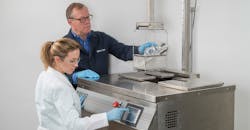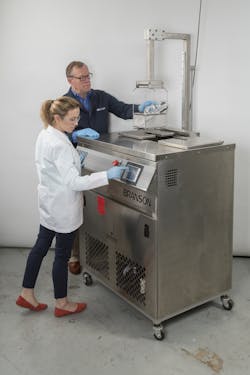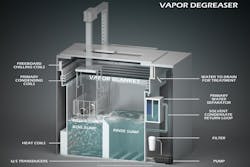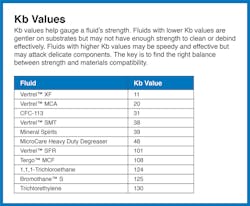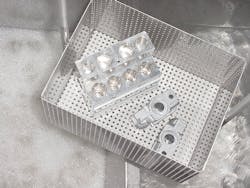12 Tips for Finding the Right Debinding Fluid
In today’s demanding manufacturing environment, many companies rely on Metal Injection Molding (MIM) to produce a variety of parts, especially those with intricate geometries and tight tolerances. In many instances, the MIM process is preferred because it allows for high production runs of end-use parts without the need for labor and time-intensive, complex machining.
Binders are an essential part of the MIM process and play an important role in forming the green parts. Whether the binders are paraffin wax, carnauba wax, stearic acid, or specialty polyethylene or polypropylene waxes, they serve the critical purpose of holding the admixture together so that it can be injection molded at high temperatures to produce green parts.
The binding agents are important in the molding process, though they are ultimately sacrificial. They must be at least partially removed before the green parts can be exposed to the high heat required for sintering. The wax binders and additives need to be selectively removed to avoid deformation and cracking during sintering. This allows the green parts to compress uniformly and sinter evenly.
Modern debinding fluids have a positive AEL (Average Exposure Limit) of 200 or higher.
Debinding parts prior to sintering is a balance of selectively eliminating some, but not all, of the binders in the shortest amount of time and with the least amount of damage to the parts structure. As the binders are progressively removed, the green parts become porous and fragile. It is essential that enough “backbone” binder stays within the green parts to give them the strength and dimensional stability to withstand the sintering process. Any remaining binder left in the parts is then burned off in the high heat of the sintering ovens as the parts are formed into their finished solid mass state.
There are a number of different ways to debind green parts. Thermal debinding uses a very gradual and sometimes lengthy (up to 24 hours or more) heating process to remove the wax binders and any additives. Catalytic debinding is performed in a gaseous acid environment where nitric or oxalic acid acts as a catalyst to break down the binders inside the parts. Catalytic debinding is done very quickly (in just a few hours). However, the investment in the technology can be significant.
Vapor Degreasing Debinding
One of the most efficient and cost-effective ways to remove binders from parts is to use specialty engineered debinding fluids inside a vapor degreaser. A vapor degreaser boils a specially engineered, non-flammable debinding fluid into a dense vapor that rises through and is trapped inside the machine. The boiling fluid and vapors combine to debind, clean, and dry the green parts inside. When the vapors reach condensing coils at the top of the machine, the coils chill the vapors back into a liquid state. This liquid falls into a trough and is made ready for another use. This recycling happens for hundreds of hours before the debinding fluid needs to be refreshed or replaced, making debinding both efficient and environmentally friendly.
Depending on the part’s material and the binders used, the binders are removed from green parts by either immersing them in the boiling debinding fluid, by holding them inside the vapor blanket inside the vapor degreaser, or a combination of both. All methods rely on the debinding fluid penetrating the parts to effectively dissolve the wax and to create enough porosity within the green parts to allow the binder to evaporate quickly before sintering.
The debinder fluid dissolves the wax binders and washes them out of the green parts. It also creates a network of interconnected cavities, allowing the debinding fluid to easily flow throughout the entire part, ensuring thorough debinding. Vapor degreasing is easily programmable and allows for excellent process control and repeatability. Green parts are consistently and effectively debound without variation through each and every cycle. Most importantly, vapor degreasing allows the green parts to come out clean, dry, and cool enough to immediately transfer them to the sintering oven. There is no extra cool-down time needed. Wax debinding in a vapor degreaser enables quick, efficient processing resulting in shorter molding cycles and faster production runs overall.
Parts are debound in either the liquid or vapor phase.
Next-Generation Fluids
Historically, legacy solvents like n-propyl bromide (nPB), trichlorethylene (TCE), and perchloroethylene (PERC) have reliably and economically filled the debinding requirements within the metal-working industry. However, newer modern-day debinding fluids are replacing TCE, nPB, hydrocarbons, and terpenes since those legacy solvents can have serious safety or environmental concerns.
Once considered the favorites of the industry, many company owners, plant managers, and environmental safety and health officers are now looking for better debinding fluid alternatives to legacy solvents that will be sustainable, more efficient, easier to maintain, and less hazardous for workers and the environment.
Fortunately, there are multiple good MIM debinding fluid alternatives on the market that will debind just as well, if not better than the legacy solvents. In many instances, modern debinding fluids do not require large investments in new equipment. Changing to a sustainable debinding fluid can deliver improved throughput, decreased energy usage, and maintain or improve debinding quality.
However, not all debinding fluids are the same. The physical properties of the debinding fluid used inside the vapor degreaser are important to the success of the debinding operations and should be chosen carefully. The ideal MIM debinding fluid will be:
Materials Compatible
The debinding fluid should be safe to use on delicate uncured substrates. It should have good materials compatibility with both the powdered materials and the binders to safeguard the integrity of the molded green parts. Debinding fluids should be compatible with a variety of substrates, including stainless steel, tool steel, and other ferrous and nonferrous alloys as well as a variety of ceramics.
The Correct Strength
Debinding fluids should offer high solvency or strength (measured by their high Kb value) which allows them to rigorously melt and dissolve the wax binders and additives. Fluids should be aggressive enough to remove the right amount of binders without damaging the parts or the non-soluble binder components.
Low Boiling
Many of the modern cleaning fluids have a lower boiling point than legacy solvents like nPB or TCE. A lower boiling point reduces the vapor degreaser start-up time, energy consumption, and cost, and requires little heat input to operate.
Fast Evaporating
Too much binder left behind in the parts could result in cracking, deformation of the backbone, or part expansion during the sintering stage. Therefore, debinding fluids should have a low latent heat of evaporation letting green parts dry more quickly, completely, and to cool down faster reducing potential damage through gasification of the trapped debinding fluid. Choosing the proper fluid can reduce debinding times as much as 75%, which improves throughput and reduces overall manufacturing costs.
There are a number of safe, sustainable MIM debinding fluid alternatives on the market today.
Low Viscosity
Debinding fluids should have both low viscosity and low surface tension. This allows the debinding fluid to flow around and into the pores inside the green parts easily. This promotes more complete debinding, especially inside tight, internal geometries.
Nonflammable
Nonflammable debinding fluids are safer for workers and do not require specialty fire- or explosion-proof equipment. Their azeotropic properties, or combination of ingredients, ensure the MIM debinding fluids are thermally stable and do not pose a fire or explosion risk.
Maintenance-Free
Except under the most extreme conditions, such as exposure to a strong base, acid, or subjected to extreme heat, debinding fluids should not “turn acid”, or break down inside the vapor degreaser. There are modern debinding fluids available that do not require any additional stabilizers or scavengers or weekly acid acceptance testing to sustain their integrity, removing maintenance time and costs.
Easy to Handle
Without stabilizers or additives required when using legacy solvents, it is easier to recycle modern debinding fluids on-site. Employees do not need the same type of intensive training to manage the next generation fluids safely. Some debinding fluids can even be shipped as “not hazardous, not regulated” throughout Europe, North America, and Asia, even by air.
Healthier for Workers
Unlike some legacy solvents that are being monitored as potential health hazards, many modern debinding fluids have higher Threshold Limit Values (TLVs), making them safer for workers to be around for longer periods of time. Many have a positive Average Exposure Limit (AEL) of 200 or higher.
Recyclable
As mentioned earlier, a vapor degreaser is also a continuous recovery and recycling system. In the process of distilling and condensing debinding fluid, it is recycled and purified. The same fluid does not need to be refreshed or replaced for hundreds of hours.
Regulatory Compliant
Today’s sustainable debinding fluids meet strict global environmental regulations and can help manufacturers replace chlorinated solvents like trichlorethylene (TCE) that, if not used properly, can contribute to groundwater and air quality problems. Most modern debinding fluids are not considered a hazardous air pollutant (HAP) and many do not require National Emission Standards for Hazardous Air Pollutants (NESHAP) permits. Most modern debinding fluids also have a low Global Warming Potential (GWP) under 10 and a zero Ozone Depleting Potential (ODP). Choosing a sustainable debinding fluid now can help companies not only meet regulations today, but prepare them for evolving future regulations.
Fast evaporating debinding fluids dry parts quickly and thoroughly.
Finding a Partner
In today’s challenging industrial world, many companies are using Mold MIM to produce a variety of parts for many industries including aerospace, automotive and medical devices. MIM is a proven process that allows for high production of quality end-use parts.
However, manufacturers are always looking for new ways to streamline their processes, to boost output and ensure worker safety. Parts debinding using a vapor degreaser with modern debinding fluids is one sustainable method that is gaining popularity within the metal-working industry. Fluid debinding provides an efficient and consistent way to remove wax binders and additives from green parts in preparation for sintering.
Fortunately, there are a number of good modern MIM debinding fluid choices that not only debind effectively, but are also safer for people and gentler on the planet.
Companies looking for help in determining the correct debinding fluid or method to use should consult with a critical cleaning partner that specializes in vapor degreasing and green part fluid debinding. Some fluid manufacturers have field engineers that conduct on-site audits to evaluate debinding methods. They can also perform comprehensive in-lab tests with sample green parts to ensure cleaning and debinding success. They can recommend the fluids and methods that will work best.
Venesia Hurtubise is a technical project chemist at MicroCare Corporation.
About the Author
Venesia Hurtubise
Technical Project Chemist
Venesia Hurtubise is a technical project chemist at MicroCare Corporation, which offers precision cleaning solutions. She has been in the industry more than five years and holds a M.S. in green chemistry from Imperial College, London. Hurtubise researches, develops, and tests cleaning-related products that are used on a daily basis in precision cleaning and medical applications. For more information, visit www.microcare.com.
